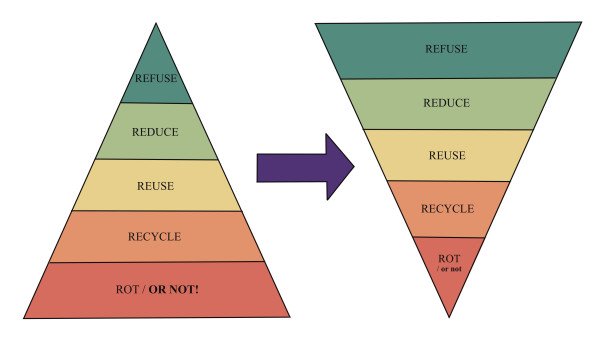The Basics
This simple little graphic shows how most of our waste ends up in landfill and how we can turn that around by making better choices at the top of the pyramid. It's here our actions have the most impact. Wasteless is offering lots of local solutions to help with this. Together we can achieve less waste and a circular economy where resources keep being reused. Here’s how:

The Waste Hierarchy
Refuse
This is where it all starts. We have a choice every time we buy something.
-
We can refuse things that do the most harm to our environment. Refuse to buy them. Refuse to use them. We hold the power.
-
Refuse to spend on waste. Producers will make what we continue to buy. Try not to let low cost convenience be our default.
-
Ask ourself if we really need the wasteful product or if there is a better alternative. The products with the least environmental cost are always the ones we resist buying.
-
We can understand the real costs of the things we use. Today we know about environmental costs we didn’t before. We can refuse to use the excuse “we didn’t know”.
-
We can refuse anything that stays in the environment infinitely longer than us or our use for it.
Reduce
-
We can be responsible consumers. Buy products that waste less to show producers what we want.
-
We can use our social channels to support and promote good products and good producers. Spread the word to help you do that if we don’t have them listed already.
-
Products that reduce waste are usually:
-
carefully chosen,
-
locally produced so there’s less transport waste,
-
have minimal or no packaging,
-
made to last because they are either unbreakable or easy to maintain and repair,
-
look good for years because of timeless design,
-
have an end-use beyond landfill.
-
-
We can be inventive with leftover food and take care with storage. Leftovers, often tastier the next day, save you time and money.
-
We can consume less overall - only what we need - which is usually much less than we think.
Less stuff = more joy… Less really is more!
“Perfection is achieved not when there is nothing more to add, but when there is nothing left to take away.” Antoine St Exupery
Reuse
-
We can re-use everything possible, because it’s waste reduction with personal benefit rather than cost or sacrifice.
-
We can unleash our creativity to upcycle and repurpose. Save or make money this way.
-
We can buy as much as possible second hand and sell back or gift things we no longer need.
-
We can save or make money this way while supporting charities and the environment.“Thrifting” makes us feel good!
-
We can reuse and refill containers, drink bottles, cups and other service ware. Have them handy in our desks, bags or cars.
-
We can keep things in use by maintaining and repairing them.
-
We can hire and share, rather than buy and own. It’s an efficient use of resources and space.
-
We can challenge ourselves to “make do with nothing new” for a set time. It usually changes how much time, energy and money we want to devote to shopping and advertising. If you love that consider the buy nothing project.
Recycle
We need to be realistic about recycling; not everything is recyclable, and not everything that is recyclable gets recycled anyway (of the plastic ever produced globally, only 9% was recycled). Recycling is usually down-cycling (turning it into a smaller quantity of an inferior product), and often this is only possible once. It also takes energy and other significant inputs (eg international transport).
-
We can find out what is recyclable and what isn’t and recycle what we can. Search our directory and listings for this.
-
We can make sure recyclable material gets to the right place, clean and separated. Again our directory can help.
-
We can store recyclable materials that aren't taken by kerbside collections until we can take them to the right place.
-
We can choose products made of recycled material.
Rot (or not).
We again have to face facts. The most important fact is that what goes into landfill never usefully or properly rots, even if it is biodegradable or compostable. It accumulates to the detriment of our environment. Landfills compact waste and seal off its toxic leachate from the wider environment. Food and greenwaste breaks down anaerobically producing methane, one of the worst greenhouse gases. This is avoidable. Organic materials (often around half the total waste), diverted from landfill and handled appropriately, return vital resources to our soils. As far as we can, we should stop organic waste going to landfill, and use any of our many composting solutions to enhance our soil.
-
We can separate our organic wastes from our general rubbish (so it doesn’t go to landfill). We can make our own compost with food and greenwaste or use the other options we have listed.
-
We can reduce our inorganic waste to landfill as well, by using all the options we have listed.
-
We can make sure that landfills may be out of our sight but not out of our minds. Rubbish doesn’t simply vanish. The amount of rubbish in our landfills is growing year on year.
We can always do a little better to reduce the impact on our environment. Remember ours is a particularly beautiful one, and we have the community and resources here to protect it. Let's do it.
If you need more inspiration watch the clips below.